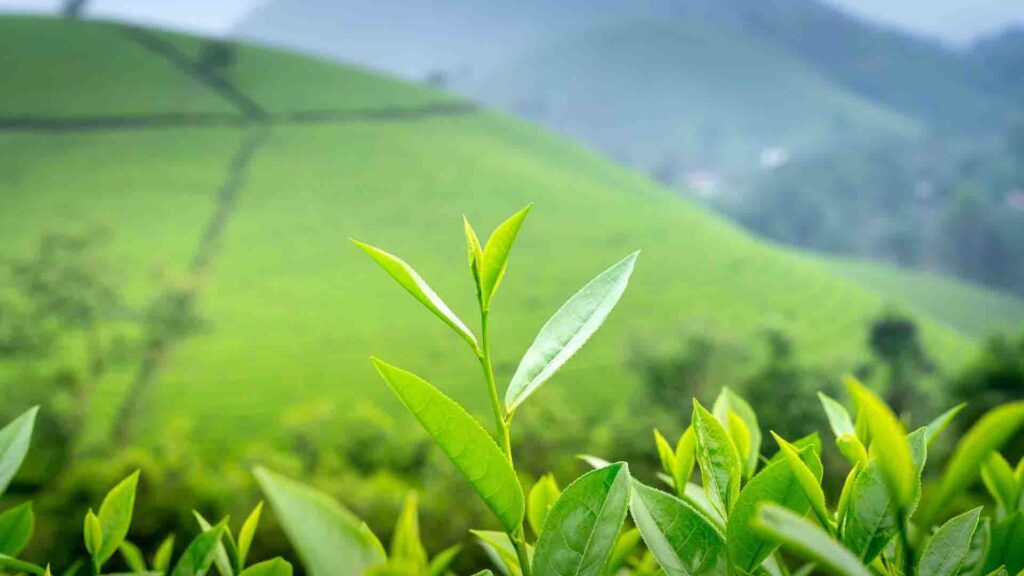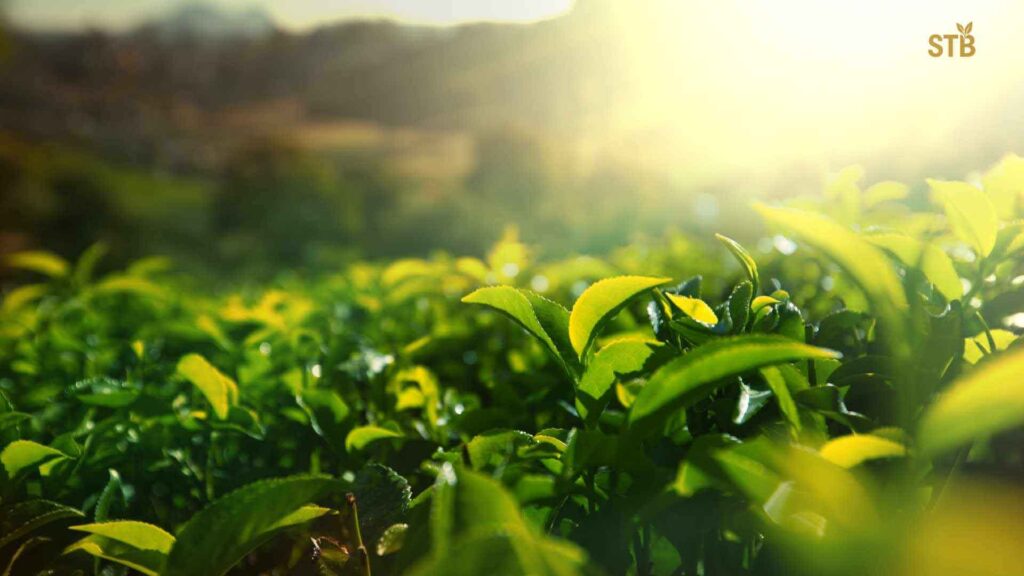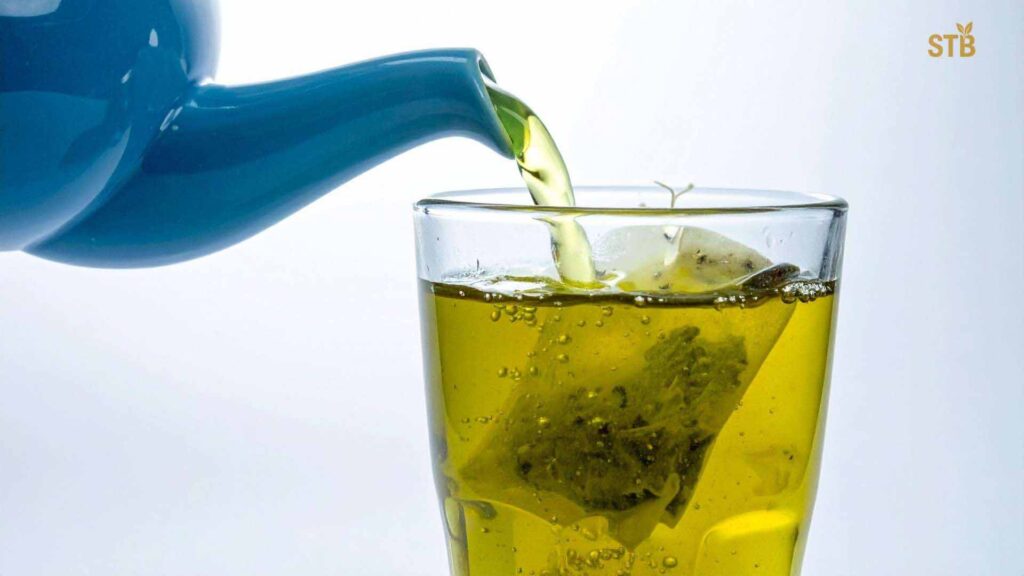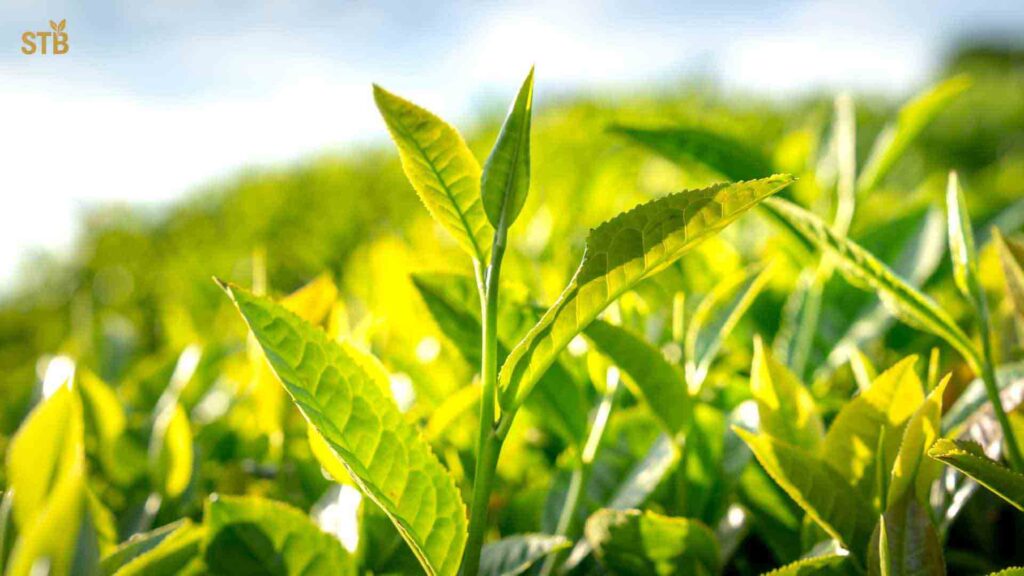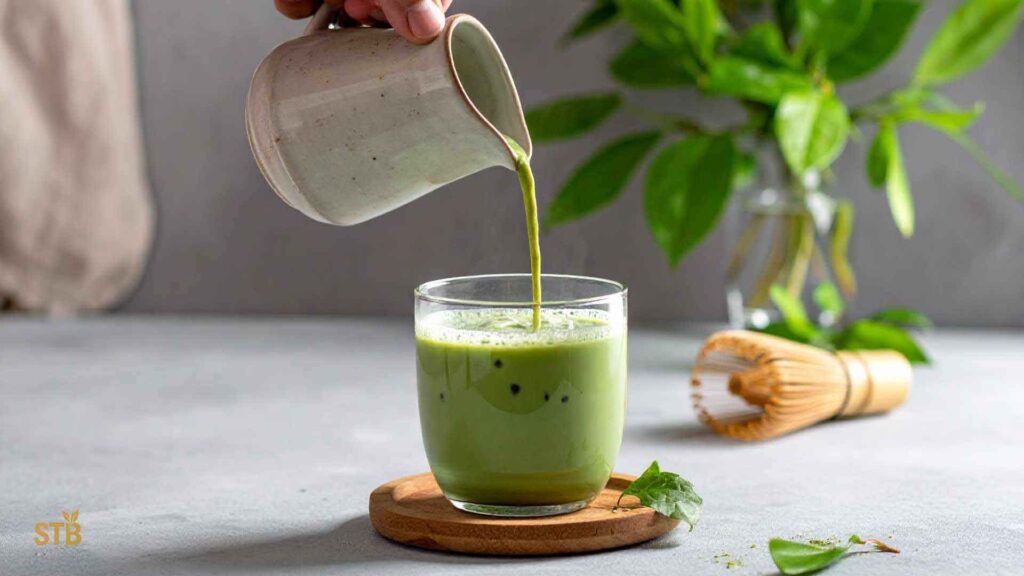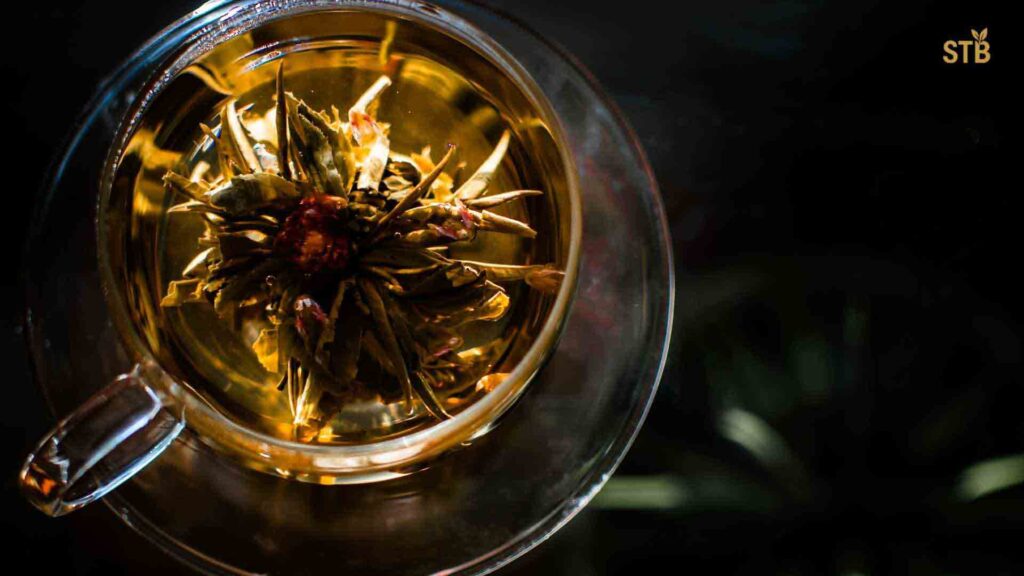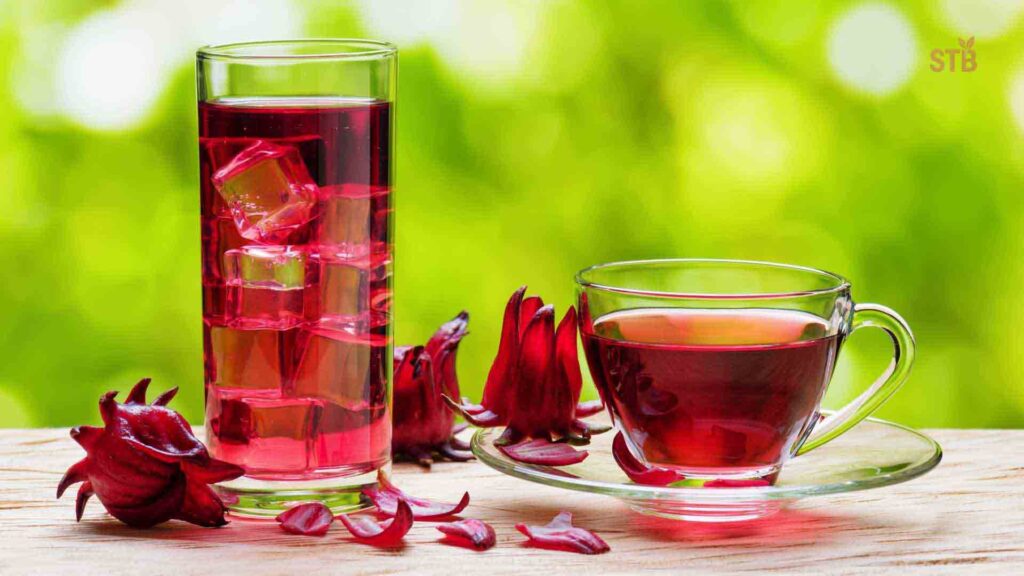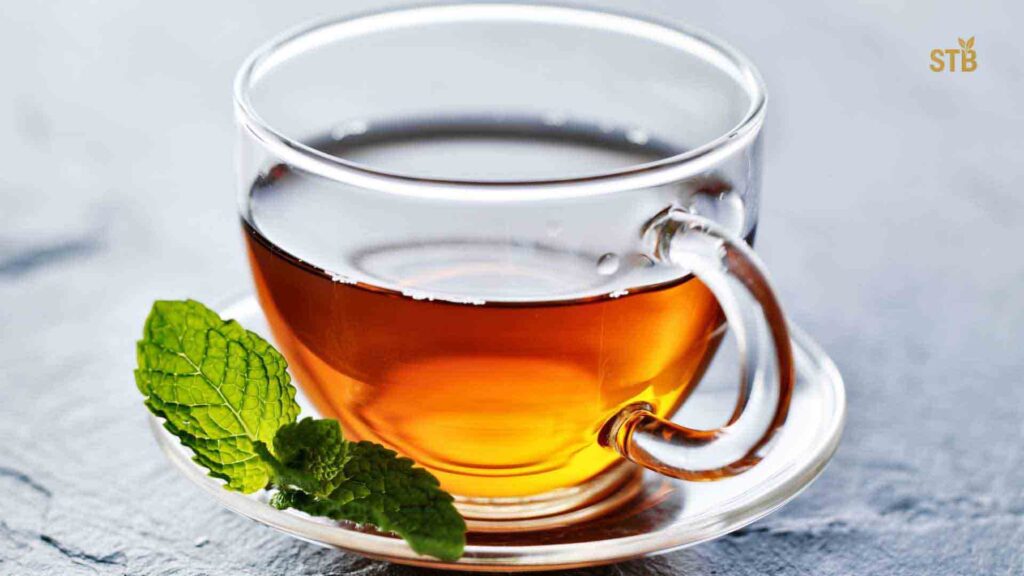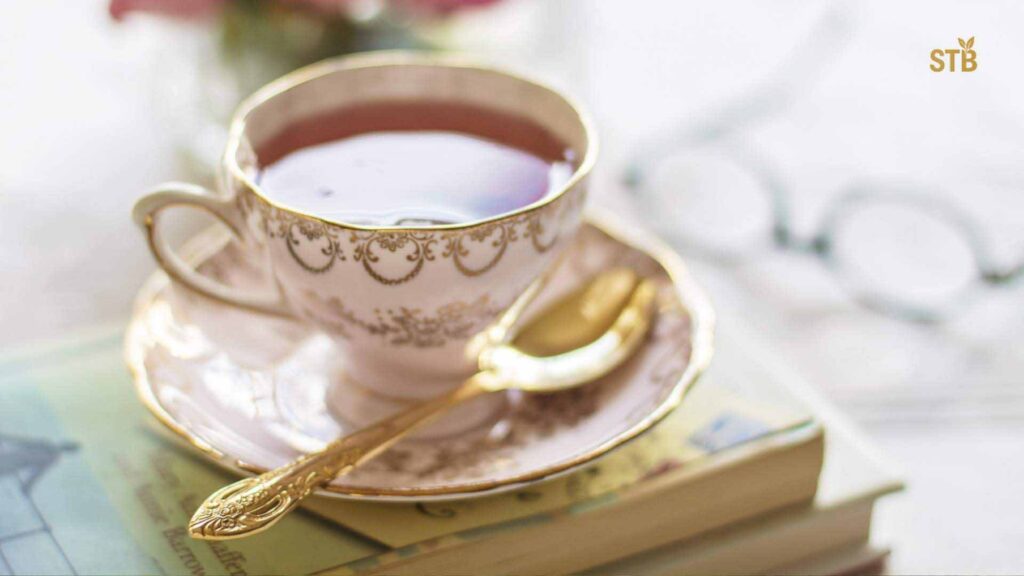Sylhet plantation in Bangladesh with rows of lush green bushes under a blue sky, illustrating Bangladeshi tea gardens. The word cha is woven into the daily life of Bangladesh. From dawn’s first light to evening gatherings, families and friends savor its comforting warmth. In fact, each morning in Bangladesh often begins with a hot cup, and evenings bring people together over another. This storytelling piece takes you on the journey of tea from the misty hills to your cup, celebrating the culture, cultivation, and unique flavors of Bangladesh’s beverages.
Bangladeshi tea is a journey of flavor and tradition. It begins in lush gardens and ends in your cup. This journey is rich with history and culture. Cha is more than a drink in Bangladesh. It is a symbol of hospitality and social life. The cha industry is a vital part of the economy.
Bangladesh is one of the world’s top cha producers. The country’s climate and soil are perfect for growing cha. Sylhet, in particular, is famous for its cha gardens. The process of making cha is both an art and a science. It involves careful cultivation and meticulous processing. Each step is crucial to the final product.
Cha gardens in Bangladesh are often family-owned. They have been passed down through generations. This tradition adds to the cha’s unique character. Bangladeshi tea is known for its strong flavor and rich aroma. It is enjoyed both locally and internationally. The tea piece, or individual leaves, is key to its quality. The journey of Bangladeshi tea is a story of dedication and expertise. It reflects the country’s rich cultural heritage. From garden to cup, it is a journey worth exploring.
Bangladesh’s Rich Tea Heritage
The history of Bangladeshi tea dates back centuries, blending colonial influence with local tradition. According to records, Bangladesh became a major cha-producing country under British rule – by 2019 it was the world’s ninth-largest producer (about 97 million kg). The British East India Company saw Sylhet’s hilly terrain as ideal for plantations. In 1854 the first commercial garden, Malnicherra Cha Estate, was planted in Sylhet. The lush climate and fertile soil proved perfect. Soon Sylhet was the heart of the industry and Sreemangal earned the nickname “tea capital” of Bangladesh.
- Early references: This beverage has a long history in Bengal. Ancient scholars like the Buddhist monk Atisa (11th century) reportedly drank the beverage, and the region was on ancient trade routes.
- 1840: European traders set up the first gardens in Chittagong using Chinese plants.
- 1843: The first recorded home-grown brew in Bangladesh was made near the Karnaphuli River in Chittagong.
- 1854: Malnicherra became Bangladesh’s first formal garden, marking the start of the commercial cha industry.
- Modern era: Today Bangladesh cultivates cha across many districts and continually seeks to improve quality and export potential.
The British legacy left enduring marks: old colonial bungalows and factory buildings still stand in many gardens as reminders of the past. When you visit a plantation like Malnicherra, you step into history – this estate not only produced Bangladesh’s first cha crop but also introduced the hand-plucking methods still used today. In short, Bangladeshi tea heritage began with colonial innovation and has blossomed into a local institution woven into the countryside.
The Origins of Bangladeshi Tea
The tea industry in Bangladesh dates back to the British colonial era. Initially, the British introduced cha cultivation to exploit the region’s fertile land. The cha plant thrived, marking the beginning of a rich cha heritage. Before long, the British established extensive cha plantations in the region. These plantations laid the groundwork for today’s thriving cha industry. From modest beginnings, the industry has grown significantly.
Sylhet emerged as the primary cha-growing area due to its favorable climate. The region’s unique terroir contributed to the distinct flavor of Bangladeshi tea. Other regions soon followed, expanding the cultivation footprint. Several factors contributed to the industry’s rapid growth, such as favorable government policies. Furthermore, investments in infrastructure and technology also played a crucial role. These advancements facilitated efficient production and transportation.
Bangladeshi cha owes much of its early success to these combined efforts. Today, it stands as a testament to a resilient agricultural sector. The country’s cha history is rich with stories of innovation and adaptation.
Key elements that shaped the origins of Bangladeshi tea include:
- British colonial influence
- Establishment of early plantations
- Sylhet as a primary region
- Government support and infrastructure development
- Expansion of cultivation to other areas
This foundation has allowed Bangladeshi tea to become a globally recognized beverage. The history of tea in Bangladesh is a tale of progress and cultural significance. It remains an essential part of the national heritage, influencing both economy and tradition.
Tea Cultivation: From Bush to Brew
Tea thrives in Bangladesh’s unique climate. Sylhet’s hills offer cool temperatures, heavy mist, and ample rainfall – ideal for high-quality cha. The soil there, rich and slightly acidic, nourishes the bushes. At a plantation, cha plants are pruned and managed on a 3-4 year cycle to produce fresh flushes. Every week during the growing season, skilled workers hand-pluck the top two leaves and a bud from each bush. This careful harvest ensures only the most tender leaves are picked, which is key to good flavor.
After plucking, the leaves enter the processing stages that turn greenery into your brew. The basic steps are well-established: the fresh leaves are spread out to wither (removing moisture), then rolled or crushed to bruise the leaves and start oxidation. For black cha (the most common type), the leaves are allowed to oxidize (ferment) until they darken and develop flavor.
Next comes drying (firing) to halt oxidation and lock in aroma. Finally, the dried cha is sorted by grade and packed. These steps – plucking, withering, rolling, oxidizing, drying, and sorting – are traditional across all cha gardens. In Sylhet’s factories, for example, workers guide leaves through each stage, preserving the tea’s nuanced character.
For example, at some Sylhet estates visitors can tour the factories and smell the sweet, earthy scent of cha during processing. This hands-on journey from leaf to cup ensures that each Bangladeshi tea carries the region’s terroir (natural flavor). Whether it’s a brisk black chai or a delicate green infusion, the result reflects generations of craftsmanship and the lush environment of Bangladesh.
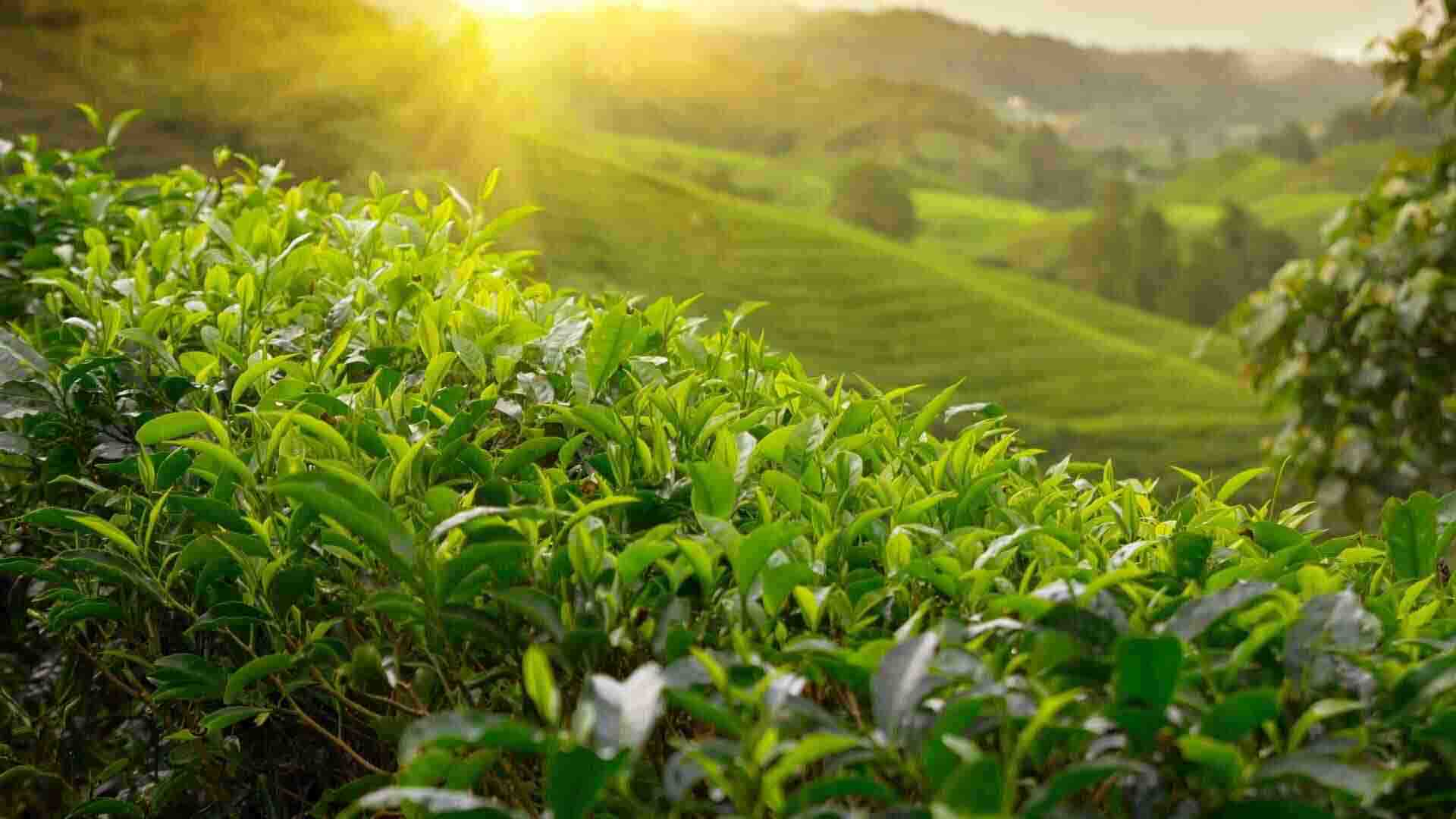
Tea Regions of Bangladesh
Most cultivation in Bangladesh occurs in the north and northeast, in hilly districts. Sylhet Division (Moulvibazar, Habiganj and Sylhet districts) remains the core region, supplying much of the country’s cha.
Malnicherra (Sylhet) and dozens of neighboring gardens are major contributors. Banglapedia confirms: cha is grown in northern and eastern districts – Sylhet, Panchagarh, Lalmonirhat, Thakurgaon, Dinajpur, Bandarban and others.
- Sylhet Division (Moulvibazar, Habiganj, Sylhet): The traditional heartland with over 150 estates. Sreemangal (in Moulvibazar) is especially famous, with miles of emerald fields.
- Panchagarh & Rangpur (Northwest): The new cha zones (Tetulia area) where estates are springing up. A Tetulia garden uses only natural farming – no machines, chemicals or irrigation.
- Chittagong Hills (Southeast): Historic cha area – the first gardens in 1840 were here. Kaptai and Bandarban still have cha estates.
- Other regions: Smaller gardens in Lalmonirhat, Thakurgaon, Dinajpur, Bandarban and nearby hills round out production.
Workers at a large garden in Sreemangal, Sylhet. Sreemangal’s name is synonymous with Bangladeshi tea – its hills are covered in cha bushes (earning it the title “cha capital” of Bangladesh).
Each region lends its brew a unique character. Sylhet’s highlands, for instance, yield bright, floral green cha. Panchagarh’s chas are often earthy. Even in the far north (near the Himalayas), some plantations focus on pure organic flavor. As one guide notes, Sylhet’s gardens “stretch across rolling hills like a green carpet,” creating one of the most picturesque landscapes in Bangladesh. These regional differences add depth to the country’s cha offerings.
Unique Flavors and Traditions
The flavors of Bangladesh’s teas vary widely. Traditionally, black cha reigns supreme: brewed strong and often served milky (the classic “dudh cha”). Sylhet’s black teas are known for brisk, malty notes and are frequently spiced or sweetened.
By contrast, green cha is lighter and more floral. Sylhet’s green teas are prized for delicate jasmine-like aromas and a refreshing finish – in fact, Sylhet’s gardens yield “some of the finest green teas” known for their distinctive profiles. Overall, Bangladeshi teas showcase both robust dark cups and elegant light brews.
In modern urban cafés, especially in Dhaka and Chittagong, younger people enjoy iced drinks, matcha lattes, and fruit-infused brews, blending global trends with local taste. Bangladesh also has many local cha creations. Masala chai (black tea with cardamom, ginger, and other spices) is ubiquitous at street stalls. Herbal and fruit chas are popular too – for example, lemon cha or morich cha made with chilies.
A recent novelty is Sreemangal’s famous seven-layer cha (Saat Rong Cha) – a tall glass drink with seven colored layers of flavored brew (each layer a different taste, from sweet milky chai to zesty juice). These special blends showcase local creativity and the versatility of cha. In short, Bangladeshi brews often highlight bold, aromatic flavors that reflect the land. Tasting them, one notes earthiness in the black teas and a garden-fresh character in the greens.
The Tea Gardens of Bangladesh: A Scenic Heritage
Bangladeshi tea gardens are a sight to behold. Nestled in lush green landscapes, these gardens offer breathtaking views. They are a blend of natural beauty and agricultural prowess. Sylhet, the heart of cha production, is renowned for its picturesque gardens. The rolling hills create a dramatic backdrop for the cha rows. Visitors often find the scenery both calming and inspiring.
Many cha gardens have been family-owned for generations. This tradition preserves rich cultural and historical ties. Families pass on their knowledge and practices to future generations. Walking through a Bangladeshi tea garden, one might see workers skillfully plucking leaves. Their expertise ensures that only the best cha leaves are selected. This meticulous process is key to producing quality cha.
The gardens are not only agricultural hubs but also biodiversity hotspots. They support a range of flora and fauna, adding to their ecological significance. Such biodiversity enhances the health and sustainability of the environment. Bangladeshi tea gardens draw tourists from around the globe. Visitors experience the charm of the gardens while learning about cha cultivation. The tranquil setting offers a perfect escape from urban life.
Key features of Bangladeshi tea gardens include:
- Scenic landscapes
- Family-owned estates
- Biodiversity and ecological significance
- Skilled leaf-plucking
- Cultural and historical heritage
Each garden tells a unique story, contributing to the rich tapestry of Bangladeshi tea. The landscape, people, and practices together create an iconic heritage. Visiting these gardens offers insights into a vital part of Bangladesh’s identity.
The Art and Science of Tea Cultivation
Tea cultivation in Bangladesh is an intricate dance of art and science. This process begins with selecting the perfect site. Factors like soil, climate, and altitude play a pivotal role. The rich soil of Bangladesh provides essential nutrients for cha plants. The monsoon season brings adequate rainfall. These conditions are ideal for nurturing robust tea bushes.
Farmers employ both traditional wisdom and modern techniques. They meticulously plan the layout of tea rows. This careful arrangement maximizes sunlight exposure and air circulation. Pruning is a crucial practice in tea cultivation. It encourages new growth and maintains the plants’ health. By cutting back the bushes, farmers ensure a plentiful harvest.
Beyond traditional methods, scientific advancements support cultivation. Research provides insights into pest control and disease management. These innovations help improve yields and quality. Environmental sustainability is becoming a focus in cultivation practices. Many gardens adopt eco-friendly approaches. These include organic fertilizers and natural pest deterrents.
Key elements in tea cultivation involve:
- Site selection based on soil and climate
- Use of traditional and scientific techniques
- Pruning for health and yield
- Environmental sustainability practices
The fusion of art and science defines Bangladeshi tea cultivation. Farmers balance ancient customs and new technologies. Their dedication results in high-quality cha, treasured worldwide. Through this synergy, they maintain Bangladesh’s prestigious place in global cha production. The commitment to excellence in cultivation reflects the pride of the Bangladeshi tea industry. Each step in the process is executed with precision. This unwavering attention ensures that every tea piece tells the story of its origin.
From Leaf to Tea Piece: The Harvesting Process
The journey of tea from garden to cup involves painstaking harvesting. Only the finest leaves and buds are selected. This precision impacts the flavor and quality of the final tea piece. Harvesting begins with skilled cha pluckers. They expertly pick young, tender leaves. Their nimble fingers work swiftly yet gently to avoid damage.
Timing is crucial in cha harvesting. Plucking occurs every week or ten days. This frequency ensures the cha plants remain productive and vigorous. The harvested leaves undergo immediate transport. They are carried with care to preserve freshness. Avoiding bruising is key to maintaining leaf quality.
Transport involves careful handling and quick processing. Minimal delays ensure optimal fermentation later. The freshness of the leaves is paramount. To achieve the finest tea piece, every step matters. Harvesting is more than just a task; it’s an art. Balancing skill and timing ensures rich, flavorful cha.
Steps in the harvesting process include:
- Selecting young leaves and buds
- Plucking with precision by skilled workers
- Frequent and timely harvests
- Careful transport to prevent damage
Every tea piece begins with this meticulous process. The dedication to quality at every stage defines Bangladeshi tea. Such attention to detail is why it garners global admiration. Through these careful practices, cha remains a cultural treasure in Bangladesh.
Traditional and Modern Tea Processing Techniques
Tea processing in Bangladesh combines time-honored methods with modern advancements. This blend ensures a superior tea piece for consumers worldwide. Traditional methods preserve the rich heritage of cha production. Initially, fresh leaves undergo withering. This process reduces their moisture. Withering softens the leaves, preparing them for further processing.
Next, the withered leaves are rolled. Rolling breaks the leaf cells, aiding in the release of essential oils. These oils contribute to the cha unique flavor and aroma. Fermentation follows rolling. The leaves are spread out to oxidize. Fermentation is pivotal in developing the cha color and taste.
Modern techniques have introduced precision to this step. Controlled environments allow for consistent fermentation. This innovation enhances quality control and uniformity. After fermentation, leaves are dried. Drying stops oxidation and locks in flavor. It ensures a long shelf life and robust taste. Sorting is the final traditional step. It separates tea pieces based on size and quality. This meticulous sorting guarantees a consistent product.
The evolution of tea processing in Bangladesh involves various techniques, including:
- Withering to reduce moisture
- Rolling to release essential oils
- Controlled fermentation for flavor development
- Drying to halt oxidation
- Sorting for quality assurance
Contemporary technology complements traditional practices. Machines streamline rolling and drying. Precision controls in modern facilities guarantee consistently high-quality cha. Though technology aids efficiency, tradition remains at the core. Modern methods reflect a commitment to preserving flavor and cultural identity. The fusion of old and new ensures Bangladeshi tea remains both distinctive and exceptional.
By embracing innovation while honoring tradition, Bangladesh continues to thrive in the global tea market. This balance is key to producing cha that delight and satisfy. The journey from leaf to tea piece highlights the dedication to excellence that defines Bangladeshi tea.
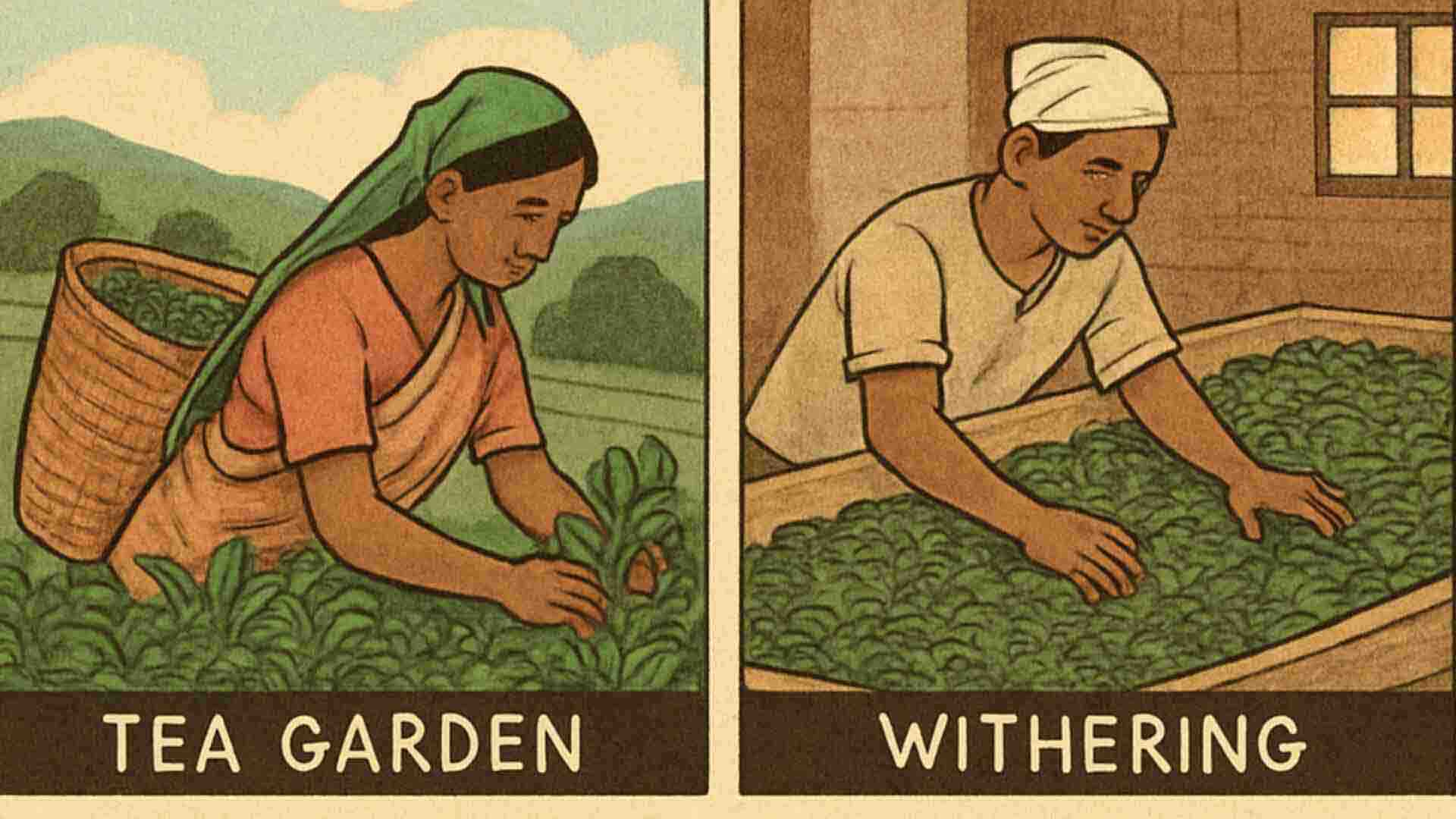
Quality Control: Tasting and Grading Bangladeshi Tea
The quality control of Bangladeshi tea ensures that only the finest leaves reach consumers. Each batch undergoes rigorous tasting and grading by skilled cha tasters. Tasting cha is an art and science. Tasters assess flavor, aroma, and color. This process involves evaluating the cha at different stages of preparation to ensure consistency.
Tea grading categorizes leaves by size and quality. Larger leaves typically fetch premium prices, while smaller pieces serve different market needs. Each grade reflects a commitment to quality and consumer preference. Various factors influence grading, including the cha appearance, strength, and potential brew. Specific standards guide these evaluations, ensuring uniformity across the cha industry.
Key components in the tasting and grading process include:
- Flavor profiling to determine taste characteristics
- Aroma assessment to capture the cha fragrance
- Visual inspection to evaluate leaf quality
- Strength testing to establish brew potency
Using a combination of traditional expertise and modern precision tools, the cha industry maintains high standards. These meticulous efforts uphold the reputation of Bangladeshi tea. As such, consumers worldwide can enjoy a truly distinctive experience with every sip. This dedication to quality sets Bangladeshi tea apart in the global market.
The Role of the Bangladesh Tea Board and Industry Support
The Bangladesh Tea Board plays a crucial role in steering the cha industry. It provides guidance and regulations essential for maintaining quality and consistency. Key responsibilities include monitoring production standards and implementing policies to support the growth of the cha sector. Through various initiatives, the board aims to elevate cha as a prominent Bangladeshi export.
Industry support extends beyond regulation. The board also helps in research and development to enhance cultivation techniques. This ensures that cha farming remains innovative and sustainable.
Support for the tea industry is multifaceted:
- Developing training programs for cha farmers
- Promoting sustainable farming practices
- Facilitating research on new cha varieties
- Collaborating with international markets
This support network is vital for overcoming industry challenges. By fostering innovation and quality, the Bangladeshi Tea Board ensures the cha sector remains robust and competitive. This dedication helps secure the future of Bangladeshi tea on the global stage.
Tea’s Cultural Role in Bangladesh
Tea in Bangladesh is more than a crop – it’s a social cornerstone. According to surveys, there are hundreds of thousands of roadside cha stalls (“tongs”) across the country. Teavendors boiling milk tea over charcoal stoves are a daily scene from Dhaka to rural towns. These tongs are community hubs: people from all walks of life chat over clinking cups of sweet, milky chai. In fact, as one report notes, serving cha (cha) is part of everyday life – it’s how families wake up in the morning and how guests are welcomed in the evening.
This cultural importance is reflected in customs. Offering cha (often with biscuits or fried snacks) is a gesture of hospitality. Offices, shops, and homes routinely pause for a “cha break.” In cold winter months or rainy evenings, a steaming cup of ginger or mint tea provides comfort. Everyone from roadside vendors to high-end cafés honors this tradition – cha ceremonies here may be informal, but they are utterly ubiquitous.
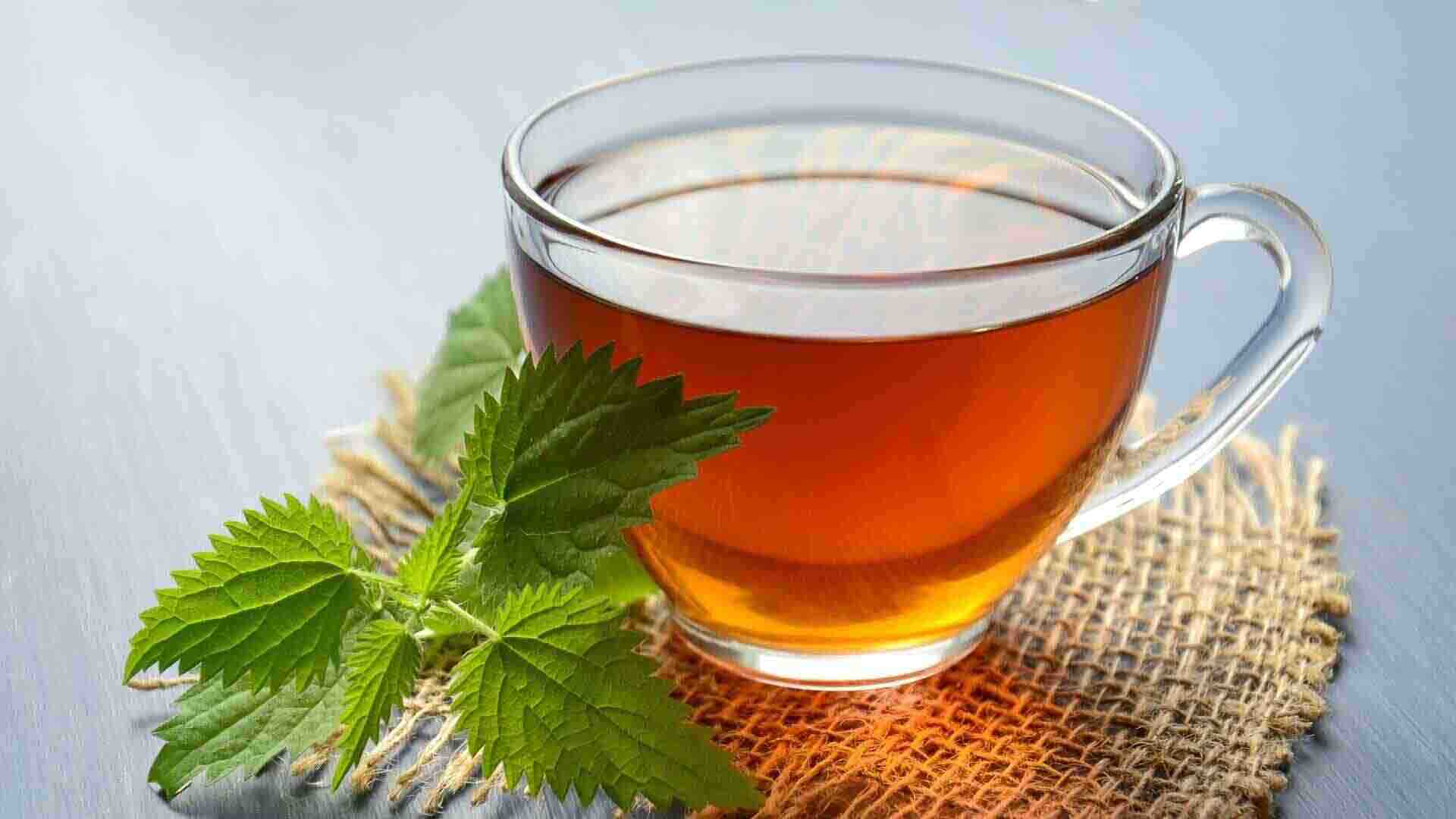
The Economic and Social Impact of Tea in Bangladesh
Bangladesh’s cha industry also has a major economic footprint. Cha is the second-largest export crop after jute, and the sector employs about 4 million people (mostly in rural areas). It accounts for roughly 1% of GDP. Production has grown steadily – from ~28,000 hectares of cha gardens in 1947 to over 56,000 hectares today. The Bangladesh Tea Board and cooperatives now support small farmers and new estates to further expand output.
Major auctions in Chittagong and Srimangal aggregate bulk harvests for buyers, helping set prices. Bangladesh used to export much of its cha, but rising domestic demand has turned it into a net importer in recent years. Still, cha remains a prized commodity: in 2023 exports jumped nearly 30% to over 1.4 million kg. This shows that producers are improving quality and finding new markets. Whether for livelihoods or for export revenue, tea is both a cultural treasure and an economic driver for the nation.
Tea contributes significantly to Bangladesh’s economy, providing both revenue and employment. The industry supports thousands of livelihoods directly and indirectly. Cha farming is particularly vital for rural regions, sustaining families who work in the gardens. Economic benefits extend to communities, boosting local businesses and services.
The social fabric of Bangladesh is intertwined with cha. It acts as a cultural bridge, uniting diverse groups over a shared love of this beverage. Gathering for cha is a cherished ritual.
Key impacts of the tea industry include:
- Job creation in rural areas
- Strengthening local economies
- Preserving cultural heritage and traditions
- Supporting community development projects
Bangladeshi tea holds an esteemed place on the global stage, contributing to international trade. Exports bolster the national economy, enhancing foreign exchange.
Societal developments driven by cha can be seen through improved infrastructure in growing regions. Such advancements are evidence of cha’s broad influence, shaping the landscape of Bangladesh both economically and socially. The industry’s influence is deep and wide-ranging, underscoring its importance to the nation.
Bangladeshi Tea Culture: Rituals, Traditions, and Social Life
Tea holds a revered place in Bangladeshi culture, transcending generations. It is more than just a beverage; it’s a symbol of hospitality and warmth.
Offering cha to guests is a cherished ritual in households. It’s an expression of welcome and respect, often accompanied by lively conversation and stories. Social gatherings frequently center around cha. Friends and families gather to enjoy “cha,” the local term for cha, which often includes milk and sugar.
Bangladeshi tea culture is enriched with traditions, such as:
- Offering cha to guests as an expression of hospitality
- Morning and evening cha time as daily family rituals
- Community gatherings centered around shared cha experiences
Cha also plays a significant role in traditional ceremonies and festivals. During these events, cha is served with traditional snacks, creating a festive atmosphere. In urban and rural areas alike, cha stalls are common meeting places. These vibrant hubs for social interaction reflect the country’s love for cha. The culture around cha in Bangladesh is a living tradition, adapting yet remaining a constant in the social fabric.
Tea in Bangladeshi Cuisine: Pairings and Popular Recipes
Cha is a cornerstone of Bangladeshi cuisine. It complements many traditional dishes, enhancing their flavors and providing a delightful contrast.
Popular snacks like samosas and pakoras are often paired with hot cha. These combinations offer a perfect balance of spicy and soothing tastes. In Bangladesh, certain dishes have become synonymous with cha time. Families and friends gather to enjoy these culinary delights together.
Some popular pairings include:
- Samosas with spicy potato filling
- Crispy pakoras served with tangy chutney
- Sweet and spicy chanachur mix
Cha’s versatility extends to its preparation. While black cha remains a favorite, green cha and herbal infusions are gaining popularity. This variety ensures there’s a cha for every palate in Bangladeshi cuisine.
Exporting Bangladeshi Tea: Global Reach and Recognition
Bangladeshi tea is renowned worldwide. Its unique flavor profile has allowed it to carve a niche in the global market. As a result, cha from Bangladesh finds its way to cha cups across the globe.
The export of Bangladeshi tea is a vital contributor to the national economy. Countries in Asia, Europe, and the Middle East are some of the main buyers of this aromatic cha. This global reach has strengthened Bangladesh’s reputation as a quality cha producer. Bangladeshi tea has received numerous international accolades. These awards recognize the quality and rich flavors of the cha. Such recognition continues to boost the confidence of exporters and the industry overall.
Key aspects of Bangladeshi tea’s global success include:
- High-quality standards maintained through stringent quality control
- Unique taste derived from the region’s distinct climate and soil
- Strong branding efforts that highlight the cha’s cultural richness
Together, these factors ensure that Bangladeshi tea maintains its place on the global stage. They enable the industry to explore new markets while securing its position in established ones.
Challenges and Innovations in the Bangladeshi Tea Industry
The Bangladeshi tea industry faces several challenges. Climate change poses a significant threat to cha cultivation. Unpredictable weather patterns affect the yield and quality of cha leaves. Market competition presents another hurdle. With many countries producing cha, Bangladesh must continuously innovate. Staying competitive requires both enhancing quality and reducing production costs.
Innovations are emerging to tackle these challenges. Sustainable farming practices are being embraced. These methods not only protect the environment but also improve cha quality. Adopting technology has been crucial for progress. From advanced irrigation systems to automated processing, technology enhances efficiency. It helps in managing resources better, ensuring high production standards.
Key challenges and innovations include:
- Climate adaptation: developing drought-resistant plants
- Technological integration: using AI for crop monitoring
- Market diversification: exploring niche markets for specialty cha
Through these innovations, the Bangladeshi tea industry aims to overcome obstacles. Continuous improvement and adaptation are vital for future success.
Sustainable and Organic Tea Farming in Bangladesh
Sustainability is becoming a cornerstone in the Bangladeshi tea industry. Cha gardens are increasingly adopting eco-friendly practices. These efforts focus on preserving biodiversity and reducing the environmental footprint. Organic farming in Bangladesh is growing in popularity. It emphasizes the use of natural fertilizers and pesticides. This results in healthier plants and contributes to superior cha quality.
Many cha gardens are transitioning to organic certification. This shift requires significant changes in cultivation methods. Despite challenges, the demand for organic cha is rising globally.
Key practices in sustainable and organic tea farming include:
- Use of natural compost: enriching soil without chemicals
- Water conservation techniques: efficient irrigation systems
- Promoting biodiversity: maintaining natural habitats within gardens
These practices not only protect the environment but also enhance the tea’s flavor profile. As more gardens embrace these methods, Bangladeshi tea’s reputation for quality continues to grow globally.

Visiting Bangladeshi Tea Gardens: Tourism and Experiences
Bangladeshi tea gardens offer breathtaking landscapes. Tourists are drawn to their lush, rolling hills. Visiting these gardens can be a sensory delight.
Travelers can witness the cha cultivation process firsthand. Some gardens provide guided tours. These tours offer insights into traditional and modern cha-making techniques. Experiencing the local culture is a key highlight. Visitors often enjoy a cup of freshly brewed Bangladeshi cha in serene surroundings.
Popular activities in tea garden visits include:
- Guided tours: education on cha production
- Tea tasting sessions: sampling different flavors
- Cultural experiences: interacting with local cha workers
These visits are more than tours; they are journeys into Bangladesh’s rich cha heritage.
The Future of Bangladeshi Tea: Trends and Opportunities
The future of Bangladeshi tea is bright. New trends are shaping the industry. Innovation and sustainability are at the forefront. Producers are adapting to consumer demands. Organic and fair-trade cha are gaining popularity. These practices promise a more responsible future. There’s also a push for global expansion. As more countries discover Bangladeshi tea, new markets open.
Key future opportunities include:
- Organic certification: tapping into health-conscious consumers
- Diversified products: offering herbal and flavored cha
- Digital marketing: reaching international audiences
The cha industry is poised for growth. With strategic actions, Bangladesh can strengthen its global cha presence.
The Enduring Legacy of Bangladeshi Tea
Bangladeshi tea holds a special place in both cultural and economic landscapes. Its rich flavor and traditions continue to captivate cha lovers worldwide. As Bangladesh nurtures this industry, the legacy strengthens. With modern techniques and sustainable practices, Bangladeshi tea is set to thrive for generations, maintaining its esteemed position globally.
The journey of Bangladeshi tea from garden to cup is a story of nature, tradition, and craftsmanship. From Sylhet’s misty hills to the steaming cha cup on your table, every sip carries the essence of Bangladesh’s fertile lands and heritage. We invite you to experience this journey firsthand by savoring an authentic Bangladeshi brew. For more insights on Bangladesh’s cha heritage, see our STB Blog. Ready to bring Bangladesh’s beverage heritage to your home? Browse our Cha Collection and savor authentic flavor today!
Frequently Asked Questions (FAQs)
Q: What makes Bangladeshi tea unique?
Bangladesh’s cha benefits from its special climate and long tradition. The country’s highland estates (like Sylhet’s) yield cha with rich, malty flavors and delicate floral notes. Being one of the world’s top producers (around 9th globally), Bangladesh offers quality cha that reflect its heritage. Local favorites – such as masala chai or seven-layer cha – and the emphasis on hand-plucking give Bangladeshi teas a distinctive character.
Q: How is tea cultivated and processed in Bangladesh?
Cha farms are planted on hillsides and pruned in 3–4 year cycles. Harvesting is done by hand almost every week, picking only the young shoots. The leaves are withered, rolled, oxidized, dried, and sorted, following traditional steps. This careful process preserves nuanced flavors. Some estates even practice natural farming (no chemicals or irrigation) to ensure purity.
Q: Where are the main tea-growing areas in Bangladesh?
The Sylhet region in the northeast is the traditional cha hub (Moulvibazar, Habiganj, Sylhet districts). Sreemangal in Moulvibazar is especially famous. Other cha zones include Panchagarh and Thakurgaon in the north, and the Chittagong Hill Tracts in the southeast. Each area’s altitude and rainfall contribute to the quality of its cha.
Q: What kinds of tea does Bangladesh produce?
Bangladesh produces several types: mainly black (fully oxidized) and green (unoxidized) chas. White and oolong varieties are also made in smaller quantities. Besides plain chas, Bangladeshis love flavored and spiced chas – for example, masala chai (spiced milk cha) and newer creations like seven-layer cha. Herbal and fruit-infused chas (e.g. lemon, ginger, hibiscus blends) are increasingly popular too.
Q: How did tea become part of Bangladeshi culture?
Tea was introduced during British rule in the 19th century. Over time, it became a local staple. Today, offering cha is a sign of hospitality in Bangladesh, and nearly every social gathering or roadside stall involves cha. In this way, cha is deeply intertwined with daily life and tradition here.
Q: What is Seven Layer Tea?
Seven Layer cha (Saat Rong Cha) is a unique Bangladeshi drink from Sreemangal. It’s served in a tall glass with seven distinct layers of colored cha – typically layers of milky cha, lemon cha, honey cha, etc. Each layer has a different flavor, creating a rainbow effect. It started as a local innovation in Sreemangal and is now a fun way to taste multiple teas at once.
Q: Which is Bangladesh’s oldest tea estate?
The Malnicherra cha Estate, near Sylhet, is Bangladesh’s first cha garden, established in 1854. It’s often called the birthplace of the country’s tea industry and remains a historic example of colonial-era cultivation.

